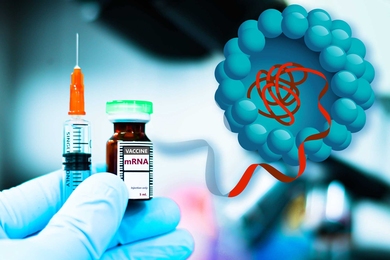An MIT researcher's mathematical model explains for the first time the distinctive structure of collagen, a material key to healthy human bone, muscles and other tissues. The new model shows collagen's structure from the atomic to the tissue scale.
An improved understanding of nature's most abundant protein could aid the search for cures to such ailments as osteoporosis, joint hyperextensibility and scurvy, all recognized as arising from diseased collagen. It could also guide engineers' development of synthetic versions of the protein, which in its healthy state is several times stronger than steel per molecule.
Biological experiments in the past have shown that collagen's universal design consists of molecules staggered lengthwise, arranged like fibers in a steel cable. Each tiny tropocollagen molecule--the smallest collagen building block--is around 300 nanometers long and only 1.5 nanometers thick. (A nanometer is one-billionth of a meter.) But why these ropy strands of amino acids--the molecular building blocks of proteins--associate to form tropocollagen molecules consistently at the same length has been unexplained until now.
The molecular model of collagen developed by Markus Buehler, an assistant professor in the Department of Civil and Environmental Engineering, started on the atomic scale. Buehler then combined elements of quantum mechanics and molecular dynamics to scale his model up and show precisely which length and arrangement of molecules were best for sustaining large weights pulling in opposite directions, a process known as tensile loading.
Buehler discovered that the ideal length of tropocollagen molecules was indeed close to 300 nanometers. His work has shown that the characteristic nanopatterned structure of collagen is responsible for its high extensibility and strength. "This is the first time a predictive, molecular model was used to explain the design features that experiments have shown for decades without understanding the rationale behind them," he explained.
"The response of materials to tensile loading has been studied in materials science for computer chips, cars and buildings, but is still poorly understood for biological materials. What we are doing is looking at biological systems on a molecular level, the same way we would examine glass or metal," said Buehler. "This represents a new way of thinking about biological matter, and it may hold the key to engineering biological systems as we design man-made devices today."
The next step in the research will be to delve deeper into the structure of collagen. "We've developed a reference point for healthy collagen. This enables us now to study how diseases or genetic mutations impact the structure," said Buehler. Learning more about the structural differences between diseased and healthy collagen could help in the development of biomimetic materials.
Buehler is optimistic about the future. "Understanding the mechanical properties of protein materials--in particular their deformation and fracture--is a frontier in materials science. We're trying to figure out how nature creates better materials than we can," he said.
The current work, which appeared in a recent issue of the Proceedings of the National Academy of Sciences, was funded by startup grants Buehler received from MIT's Department of Civil and Environmental Engineering and MIT's School of Engineering.
Katharine Stoel Gammon is a student in MIT's Graduate Program in Science Writing.
A version of this article appeared in MIT Tech Talk on November 15, 2006 (download PDF).






